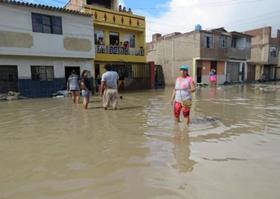
Peruvian fruit and vegetable exporters are assessing the impact of heavy rains that have been battering coastal regions since December, killing dozens of people and causing widespread flooding and damage to roads and houses.
Piura, Lambayeque, Ica, Lima, Huancavelica, Arequipa and Tumbes are among the 11 regions that have declared a state of emergency.
Ricardo Polis, president of producer and exporter guild AGAP told Fruitnet that banana producers in Piura are bearing the brunt of the rains but it was too early to assess the extent of the losses.
'Fortunately, the table grape, mango and blueberry export season ended in January and very little damage has been sustained,' he said. 'The avocado campaign has just got underway, but the advantage of this fruit is that producers can leave it on the tree until they are ready to harvest it.
Polis added the main production zones for pomegranates were outside the affected area, while the citrus season is not due to get underway until April when the rains are expected to have ended.
Polis said he was confident that overall export volumes for the first half of the year would still be up on 2016 as shipments had risen sharply in January.
Andres Jochamowitz of Proagro said that as the fact that the bulk of Peru's exports take place in the second semester meant that overall volumes for 2017 were unlikely to be impacted by the wet weather. 'The climate has affected production in the first half of the year but the biggest culprit has been the higher temperatures we saw before the rains,' he told Fruitnet.
However, figures from the Lima Chamber of Commerce show exports of a number of products were down significantly in January and February as a result of the rain. The organisation said mangoes, asparagus, onions, sugar cane, cocoa and quinoa are the six products that have been most affected.
Trade data shows that US$40m of asparagus was exported in the first two months of 2017 compared with US$80m in the year-earlier period, while in mangoes shipments had fallen from US$132m to US$73m.
Export figures for January released by AGAP show that overall fruit exports were up 13.6 per cent in January compared with the year-earlier period, with grape exports registering a 28.2 per cent increase.
According to a report in El Comercio de Perú, the rains have put banana producers in Piura on a state of high alert. Mario Arellano, who works for the regional government, told the newspaper that there was a danger that plants could rot due to the excess water.
'The biggest threat to banana producers is that the fruit will spoil before it reaches the port – either because it has ripened before it’s had a chance to be transported, or because the excess water has caused the plant to rot,” he said.
Arellano pointed out that although exporters had experienced problems accessing the port of Paita last month, these had now been resolved. “The issue now is that growers can’t get the fruit out of the farms,” he added.
The latest available figures from Adex show that exports of organic bananas in January were at similar levels to 2016 at US$14m. However, producer associations in Piura warns that the following months will see volumes register a decrease on last year.
Experts believe the rains, caused by a phenomenon known as El Niño Costero, will last until the first week in April. This would no doubt lead to an overall fall in agricultural exports during the first half of the year, Posada said.
The agriculture committee in the regional government of Piura estimates that US$4.6m of losses have been caused to the region’s hydraulic infrastructure, with another US$7m in lost exports.
Polis said the government's priority was to help citizens who had lost their homes or were cut off due to damaged highways. 'They are priority right now. Once the rains have ceased we will be able to assess the situation in the industry.'
Agriculture minister José Manuel Hernández stressed that while 1,200ha of agricultural land in Piura had been affected by the rains, this represents less than 0.5 per cent of the 250,000ha of production in the region.



